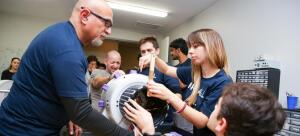by
John R. Fischer, Senior Reporter | December 13, 2023

Scientists at the NYU Langone department of radiology MRI4ALL Hackathon designed an ultra-low-field, open-source MR scanner in four days.
At the annual MRI4ALL Hackathon, hosted by NYU Langone’s department of radiology, 52 scientists from 16 organizations built a functional MR scanner in just four days.
The event began on October 16, with participants dividing into four groups to assemble the magnet, build the gradient coils, put together the radio frequency transmitter and receiver, and develop the software for controlling these components and displaying images, respectively.
On the final day, the teams combined their parts in two-to-three hours into an 80 pound, two-foot-wide machine with a bore wide enough to scan a wrist or ankle. After multiple technical modifications, the scanner produced an accurate image of a phantom.



Ad Statistics
Times Displayed: 46603
Times Visited: 1410 MIT labs, experts in Multi-Vendor component level repair of: MRI Coils, RF amplifiers, Gradient Amplifiers Contrast Media Injectors. System repairs, sub-assembly repairs, component level repairs, refurbish/calibrate. info@mitlabsusa.com/+1 (305) 470-8013
“A main achievement of the hackathon is that our research community now has a fully open-source MR system available, which can be used for education and for exploring novel imaging techniques," Kai Tobias Block, associate professor in the department of radiology at NYU Langone, told HCB News. "Access to MR resources has traditionally been highly restricted.”
Conventional MR scanners, with magnet strengths of 1.5 or 3 Tesla, typically weigh 17 tons and cost millions of dollars. The scanner built at the Hackathon used an array of 990 N40UH permanent magnets to create a homogeneous magnetic field of 0.043 Tesla in the center.
While clinical use of ultra low-field scanners is still being tested, the system does create images and can be used for educational purposes, with all software and resources to be released as open-source packages.
The participants named it the Zeugmatron Z1, after “zeugmatography,” a term coined by Nobel Prize recipient Paul Lauterbur when he invented the MR imaging principle 50 years ago.
Block says strict commercial vendor research agreements and the cost of using clinical MR scanners hamper the speed and progression of research. Low-field, open-source options are a cheap alternative to prototype novel acquisition techniques and teach students, and he and his colleagues have already received several inquiries from other centers about reproducing it.
“We are very curious to see what all these researchers will create when they get access to an open-source MR platform, and we think that many innovations will be created using the low-field platform and subsequently translated to clinical MR scanners,” said Block.
All the designs for the components, many of which were 3D printed, and the software and tools for the magnet design are available
on the project website.
Back to HCB News

